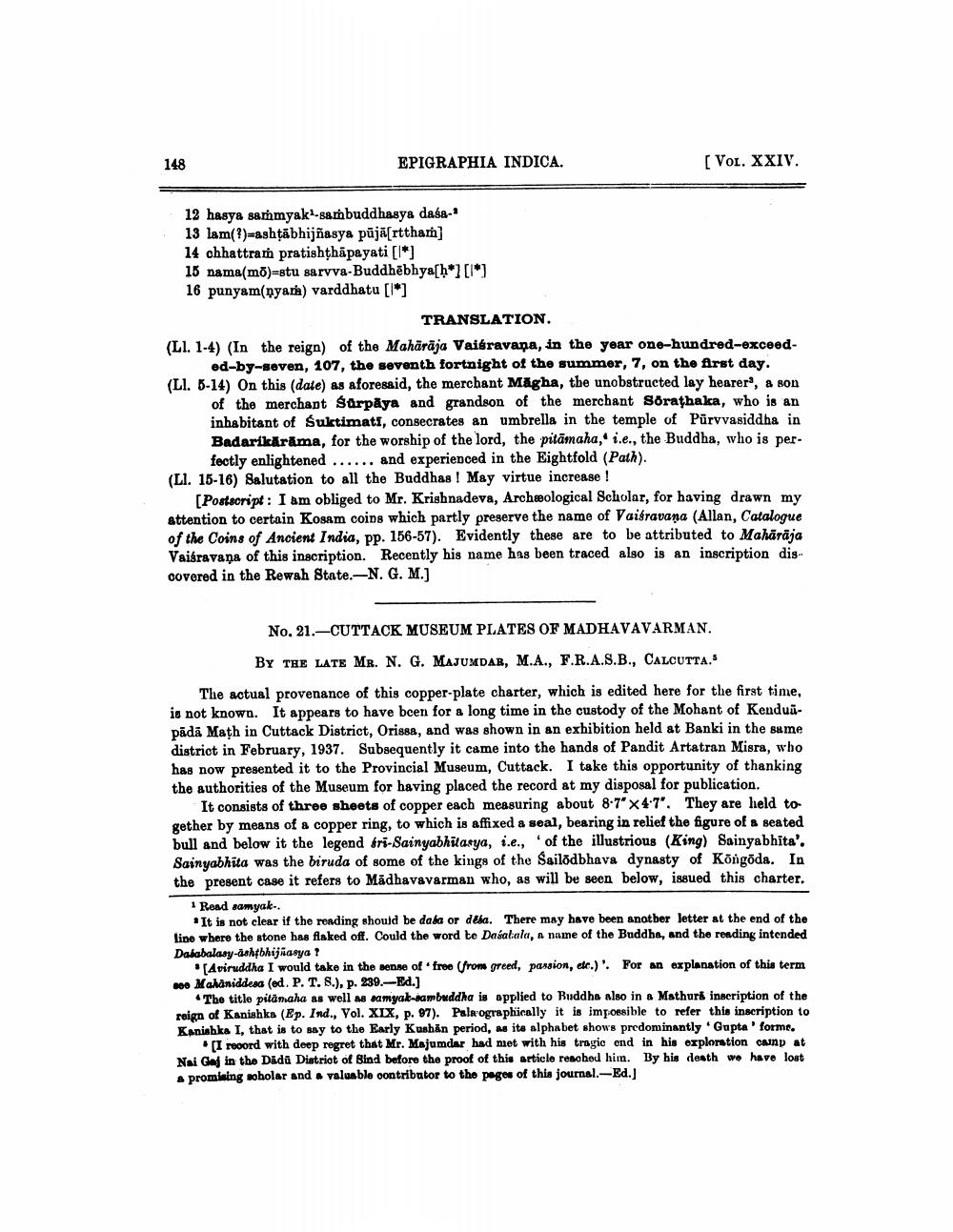________________
148
EPIGRAPHIA INDICA.
[Vol. XXIV.
12 hasya sarmyak--sambuddhasya dasa13 lam(?)=ashțābhijñasya pūjā[rttham) 14 chhattram pratishthāpayati [l*] 15 namamā)=stu sarvva-Buddhēbhya[h*] [*] 16 punyam(nyara) varddhatu [18]
TRANSLATION. (Ll. 1-4) (In the reign) of the Mahārāja Vaisravana, in the year one-hundred-exceed
ed-by-seven, 107, the seventh fortnight of the summer, 7, on the Arst day. (LI. 6-14) On this (date) as aforesaid, the merchant Magha, the unobstructed lay hearer, a son
of the merchant Sorpāya and grandson of the merchant Sorațhaka, who is an inhabitant of Sultimati, consecrates an umbrella in the temple of Pūrvvasiddha in Badarikarama, for the worship of the lord, the pitämaha, i.e., the Buddha, who is per
fectly enlightened ...... and experienced in the Eightfold (Path). (LI. 15-16) Salutation to all the Buddhas ! May virtue increase!
[Postscript: I am obliged to Mr. Krishnadeva, Archeological Scholar, for having drawn my attention to certain Kosam coins which partly preserve the name of Vaisravana (Allan, Catalogue of the Coins of Ancient India, pp. 156-57). Evidently these are to be attributed to Maharaja Vaisravana of this inscription. Recently his name has been traced also is an inscription discovered in the Rewah State.-N. G. M.]
No. 21.-CUTTACK MUSEUM PLATES OF MADHAVAVARMAN.
BY THE LATE MR. N. G. MAJUMDAR, M.A., F.R.A.S.B., CALCUTTA.
The actual provenance of this copper-plate charter, which is edited here for the first time, is not known. It appears to have been for a long time in the custody of the Mohant of Kenduüpādā Math in Cuttack District, Orissa, and was shown in an exhibition held at Banki in the same district in February, 1937. Subsequently it came into the hands of Pandit Artatran Misra, wbo has now presented it to the Provincial Museum, Cuttack. I take this opportunity of thanking the authorities of the Museum for having placed the record at my disposal for publication.
It consists of three sheets of copper each measuring about 8.7" x 4.7'. They are held together by means of a copper ring, to which is affixed a seal, bearing in relief the figure of a seated bull and below it the legend bri-Sainyabhitasya, i.e., of the illustrious (King) Sainyabhita'. Sainyabhita was the biruda of some of the kings of the Sailodbhava dynasty of Köngöda. In the present case it refers to Madhavavarman who, as will be seen below, issued this charter.
Read samyak..
* It is not clear if the reading should be data or dea. There may have been anatber letter at the end of the line where the stone has flaked off. Could the word te Daáalala, a name of the Buddha, and the reading intended Dalabalasy-ashtbhijiasya
[Aviruddha I would take in the sense of free from greed, passion, etc.)'. For an explanation of this term 100 Mahaniddesa (ed. P. T. 8.), p. 239.-Ed.)
The title pitämaha as well as samyak-sambuddha is applied to Buddhs also in a Mathurs inscription of the reign of Kanishka (Ep. Ind., Vol. XIX, p. 97). Paleographically it is impossible to refer this inscription to Kanishka I, that is to say to the Early Kushån period, as its alphabet shows predominantly Gupta' forme.
[I record with deep regret that Mr. Majumdar had met with his tragic end in his exploration caip at Nai Gad in the Dadu District of Sind before the proof of this article reached him. By his death we have lost A promising soholar and valuable contributor to the pages of this journal.-Ed.]




